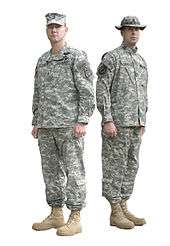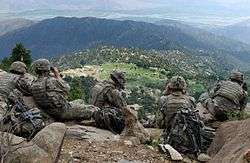Universal Camouflage Pattern
| Universal Camouflage pattern | |
|---|---|
 A Universal Camouflage Pattern fabric | |
| Type | Military camouflage pattern |
| Place of origin | United States of America |
| Service history | |
| In service | 2005–present (to be discontinued in 2019) |
| Used by |
|
| Wars |
War in Afghanistan Iraq War |
| Production history | |
| Designed | 2004 |
| Produced | 2004–present |
| Variants | Universal Camouflage Pattern Delta (UCP–D)[2][3] |

The Universal Camouflage Pattern (UCP), also unofficially referred to as ACUPAT (Army Combat Uniform Pattern) or Digital Camouflage (digicam), is a digital military camouflage pattern formerly used in the United States Army's Army Combat Uniform.[4] The pattern was chosen after several laboratory and field tests that occurred from 2003 to 2004, although it has been established that UCP may well have been adopted without field testing against other patterns.[5] Its pixelated pattern is a modification of the United States Marine Corps' MARPAT camouflage pattern which is similar to the Canadian CADPAT scheme.[6][7]
The effectiveness of the pattern was questioned, leading to several research programs being conducted to modify or replace the current standard issue pattern.[8] In July 2014, the Army announced that Operational Camouflage Pattern had been selected as the replacement pattern, and will completely replace the former pattern by the end of September 2019.[9][10][11][12]
Selection

Phase I
Initial patterns and colors
Three patterns were developed, called All Over Brush, Track, and Shadow/Line.[13] For each pattern, there were four color combinations, which corresponded to a specific type of terrain, however, all four patterns used tan as their base color.[13] The three remaining colors were green, brown, and black for the Woodland pattern, dark tan, khaki, and brown for the Desert pattern, light gray, medium gray, and black for the Urban pattern, and dark tan, light gray, and brown for the Desert/Urban pattern.[13]
Test sites
There were fifteen evaluations, which took place at Fort Benning, Fort Polk, Fort Irwin, Fort Lewis, and Yakima, Washington.[13] The camouflage patterns were then rated on their blending, brightness, contrast, and detection by U.S. Army soldiers, during the daytime, and also at night using night vision devices.
Elimination of patterns
Following testing, the Shadow Line pattern was eliminated entirely, along with the urban and desert/urban patterns of All Over Brush. All four of the Track patterns were accepted along with All Over Brush's woodland and desert patterns.[13]
Phases II and III
The patterns were then modified and tested alongside a newly introduced "Contractor-Developed Mod" pattern, MultiCam. Near infrared testing determined that black, medium gray, and medium tan were the only colors that gave acceptable performance.[13]
Phase IV (system level)
All four remaining patterns, desert Brush, MultiCam, Woodland Track, and Urban Track were then tested alongside each other in urban, woodland, and desert environments.
Results
The desert Brush design received the best overall mean daytime visual rating. Contractor developed pattern received highest rating in woodland environments, but low ratings in desert and urban environments. Urban Track was generally the 3rd or 4th worst performer at each site, but was the best performer in nighttime environments. Infrared testing showed negligible differences in the performance of the four patterns. Natick rated the patterns from best to worst as: Desert Brush, Woodland Track Mod, Contractor-Developed Mod, and Urban Track.[14]
Color selection
The color scheme of the Army Combat Uniform is composed of tan (officially named Desert Sand 500), gray (Urban Gray 501), and sage green (Foliage Green 502). The pattern is notable for its elimination of the color black.[15] Justification given for the omission of black was that black is a color not commonly found in nature.[16] Pure black viewed through night vision goggles can appear extremely dark and create an undesirable high-contrast image. This argument was not accepted by the Canadian forces or the Marine Corps when they adopted the preceding CADPAT and MARPAT patterns respectively.
Controversy

The U.S. Army incorrectly reported to the media that the basis for the UCP was the Urban Track pattern, which had been modified through the removal of black from the pattern and pixelated. Pattern comparisons subsequently established that the information provided by the U.S. Army was incorrect, and that the pattern was simply a three-coloured version of MARPAT, a derivative of the Canadian CADPAT scheme. No evidence has been presented by the U.S. Army that the new UCP pattern had undergone proper field testing.
Following building criticism of the poor effectiveness of the pattern in most terrains like the Afghan and Middle Eastern theatres of operations, the use of the pattern was discussed within the US Senate.
When passed by the Senate, House of Representatives Bill 2346 required the Department of Defense to "take immediate action to provide combat uniforms to personnel deployed to Afghanistan with a camouflage pattern that is suited to the environment of Afghanistan." The Army subsequently initiated re-evaluation of existing and alternative camouflage patterns to determine if this was a necessary action.[17] In recent tests conducted by the U.S. Army's Natick Soldier Systems Center (NSRDEC), results indicated that three other patterns did significantly better than UCP in desert and woodland environments.[18] Four commercial submissions were tested to replace UCP for Army use.[19][20]
Discontinuation and replacement
In 2014, the United States Army discontinued the Universal Camouflage Pattern,[21] and Army researchers worked on a new and better camouflage.[21] Four new patterns were tested to give soldiers different patterns suitable for different environments, plus a single neutral pattern, to be used on more expensive body armor and other gear.[21] The selection involved hundreds of computer trials as well as on-the-ground testing at half a dozen locations around the world.[21] In May 2014, the Army announced that a pattern called Scorpion, a pattern similar to MultiCam that was developed for the Objective Force Warrior program in 2002 and modified in 2009 (W2 version), had been chosen as the replacement for UCP.[12] On 31 July 2014, the Army formally announced that the Operational Camouflage Pattern would begin being issued in uniforms in summer 2015. The name Operational Camouflage Pattern is to emphasize its use beyond Afghanistan to all combatant commands, with a family of versions, including a dark jungle-woodland variant and a lighter pattern for deserts.[11] The Universal Camouflage Pattern will officially be retired by the Army by the end of September 2019.[9][10][22] As the federal military began phasing out the UCP, many state defense forces began adopting it as their uniform.[23][24]
Users




References
- ↑ "We should permanently post more U.S. troops abroad. For their own sake". Newsweek. Newsweek. August 28, 2017. Retrieved August 28, 2017.
- ↑ "UCP-D:This Is What Happened The Last Time The US Army Created A Pixelated Camo Pattern - Soldier Systems Daily".
- ↑ "USA - Camopedia". camopedia.org.
- ↑ "ACU Presentation". ArmyStudyGuide.com.
- ↑ Carroll, Ward (9 April 2007). "Defense Tech: Singing the ACU Blues". Defense Tech. Military Advantage, A Monster Company.
- ↑ "Facts: Army Combat Uniform". U.S. Army Training and Doctrine Command Office of the Chief of Public affairs. U.S. Army. 14 June 2004. Archived from the original on 20 August 2012.
- ↑ Cramer, Guy (2004). "Dual Texture - U.S. Army Digital Camouflage". United Dynamics Corp.
- ↑ Engber, Daniel (6 July 2012). "Lost in the Wilderness, the Military's Misadventures in Pixelated Camouflage". State. Retrieved 27 September 2012.
- 1 2 https://www.army.mil/e2/c/downloads/396739.pdf
- 1 2 http://www.armyuniformchanges.com/wp-content/uploads/2015/03/New-OCP-Uniform-Fielding-Update.jpg
- 1 2 Gould, Joe (31 July 2014). "Army Announces Rollout Date for New Camo". Armytimes.com. Gannett. Archived from the original on 1 August 2014.
- 1 2 "Army Selects New Camouflage Pattern". Military.com. 23 May 2014.
- 1 2 3 4 5 6 Dugas, Anabela; Kramer, F. Matthew (15 December 2004). "Universal Camouflage For The Future Warrior". U.S. Army Natick Soldier Center. Archived from the original on 11 August 2013.
- ↑ Dugas, A.; Zupkofska, K. J.; DiChiara, A.; Kramer, F. M. (1 December 2004). "Universal Camouflage for the Future Warrior" (PDF). Natick, MA: U.S. Army Research, Development and Engineering Command, Natick Soldier Center. ADA433081.
- ↑ Cramer, Guy (2004). "New Digital U.S. Army Combat Uniform eliminates Black in pattern". HyperStealth Biotechnology Corp.
- ↑ "Frequently Asked Questions (FAQs) Army Combat Uniform". Program Executive Office Soldier. U.S. Army. 24 February 2012. Archived from the original on 14 February 2013.
- ↑ Maze, Rick (21 June 2009). "Troops in Afghanistan would get new uniforms". ArmyTimes. Army Times Publishing Company. Retrieved 13 August 2009.
- ↑ Cox, William (17 September 2009). "UCP Fares Poorly in Army Camo Test". Army Times. Army Times Publishing Company. Retrieved 17 September 2009.
- ↑ Lance M. Bacon (10 March 2012). "Army Weighs 4 Options to Replace Current Camo". Army Times. Retrieved 15 March 2012.
- ↑ Eloise Lee (2 March 2012). "The Army Is Eyeing These Cool New Camouflage Patterns". Business Insider. Retrieved 15 March 2012.
- 1 2 3 4 Dickson, Caitlin (14 October 2013). "The Army's $5 Billion New Uniform Already Being Replaced". The Daily Beast. IAC/InterActiveCorp.
- ↑ Cox, Matthew (6 August 2014). "Army Unveils Design Changes for New Camo Uniform". Military.com. Military Advantage, A Monster Company.
- ↑ "What is the CSMR?". California State Military Reserve. Retrieved 20 May 2018.
- ↑ Mendie, Ubon (16 September 2010). "New York Guard Members to Begin Wearing Modified ACU". dmna.ny.gov. Retrieved 20 May 2018.
- ↑ https://www.mmea.gov.my/artikel/Tender_SebutHarga/sebutharga_april_2015/Bekalan%20Pakaian%20Celoreng%20Digital/Kenyataan%20Sebut%20Harga%20Bekalan%20Pakaian%20Celoreng%20Digital.pdf
- ↑ https://specijalne-jedinice.com/Inostranstvo/Region/Specijalna-antiteroristicka-jedinica-Crne-Gore-SAJ-English.html#sthash.CADkM9tb.dpbs
- ↑ https://specijalne-jedinice.com/Srbija/SAJ-English.html#sthash.H0GnUwyq.dpbs
- ↑ https://specijalne-jedinice.com/Srbija/Zandarmerija-English.html#sthash.6Ofm6yco.dpbs
- ↑ "Bohdan Company - Military Land". Retrieved 22 August 2018.
- ↑ "Kherson Company - Military Land". Retrieved 22 August 2018.
- ↑ "Ternopil Company - Military Land". Retrieved 22 August 2018.
- ↑ "Skif battalion - Military Land". Retrieved 22 August 2018.
External links
| Wikimedia Commons has media related to Universal Camouflage Pattern. |
.jpg)